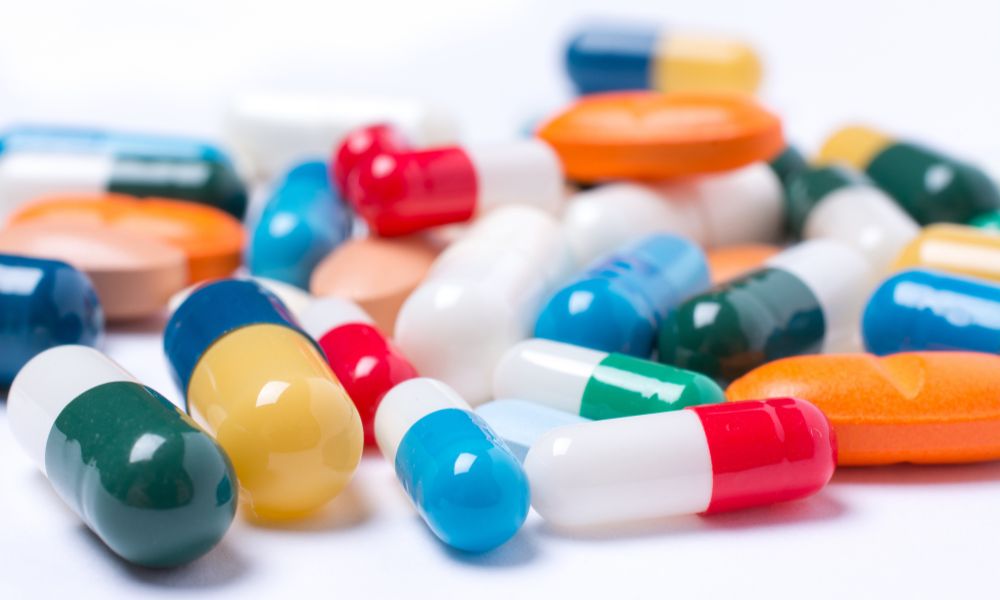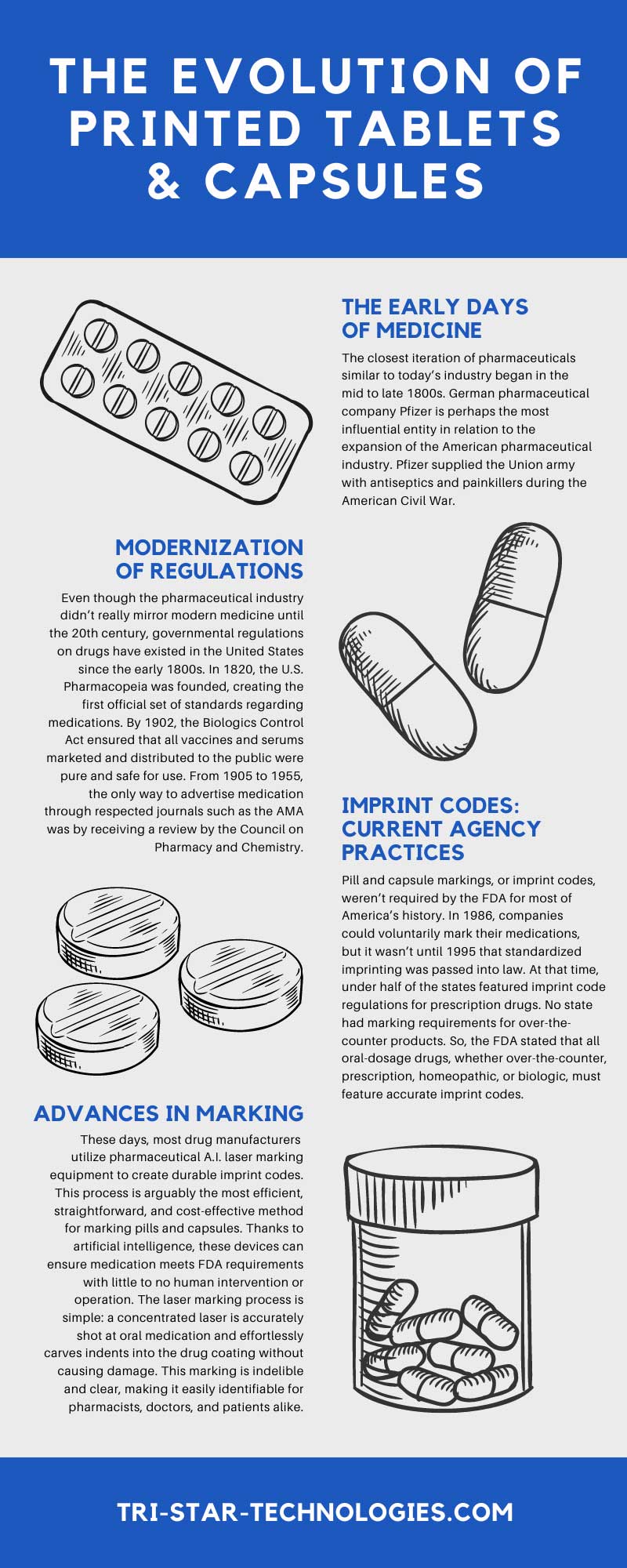The Evolution of Printed Tablets & Capsules

It’s estimated that over half of all Americans take, at the minimum, two pills every day. This statistic doesn’t even factor in individuals who consume over-the-counter medications such as ibuprofen or allergy drugs. In total, there are well over 20,000 prescription drug products that the FDA has deemed safe for marketing and public use. Why are these numbers so important? Millions of people take daily medications, and there are tens of thousands of drugs to choose from. For those reasons alone, it’s no surprise that the pharmaceutical industry ensures each and every pill is marked properly.
The words and numbers etched onto your medication aren’t just there for your convenience. This descriptive system can save lives. However, ensuring every pill has accurate markings wasn’t the “norm” for most of human history. In fact, the regulations and pharmaceutical standards we see in the industry today were invented quite recently. Let’s explore the evolution of printed tablets and capsules, the value they serve society, and how this process is successfully conducted.
The Early Days of Medicine
While humans have created, sold, and used forms of medicine for thousands of years, the creation of pharmaceuticals was much more recent. The apothecaries of the middle ages were perhaps the first individuals to market commercial treatments and medications for customers. They’d sell their goods at markets, travel from town to town making deliveries, or even set up actual storefronts. As you can probably imagine, regulations were very loose when it came to the drugs apothecaries sold. In truth, a good portion of their products didn’t even accomplish their marketed effects.
The closest iteration of pharmaceuticals similar to today’s industry began in the mid to late 1800s. German pharmaceutical company Pfizer is perhaps the most influential entity in relation to the expansion of the American pharmaceutical industry. Pfizer supplied the Union army with antiseptics and painkillers during the American Civil War.
Interest in pharmaceuticals directly lead to American companies such as Bayer, the creator of Asprin. Thanks to industrialization, many fields of medicine benefited from advances in technology, research, and resources, leading to an explosion of more modern medication practices. Drug development was increasing, with medications such as insulin and penicillin hitting the market. By the conclusion of the 1950s, the U.S. and U.K. dominated the pharmaceutical industry globally.
Modernization of Regulations
Even though the pharmaceutical industry didn’t really mirror modern medicine until the 20th century, governmental regulations on drugs have existed in the United States since the early 1800s. In 1820, the U.S. Pharmacopeia was founded, creating the first official set of standards regarding medications. By 1902, the Biologics Control Act ensured that all vaccines and serums marketed and distributed to the public were pure and safe for use. From 1905 to 1955, the only way to advertise medication through respected journals such as the AMA was by receiving a review by the Council on Pharmacy and Chemistry.
Perhaps the most defining moment in pharmaceutical regulations was the creation of the Food and Drugs Administration (FDA). Passed by President Theodore Roosevelt in 1906, the Food and Drugs Act demanded stricter standards in relation to drug labeling and marketing. This is the earliest example of standardized medicine marking. These regulations were expanded in 1938, following the tragic death of 107 individuals who consumed the drug Elixer Sulfanilamide. The FDA received pressure to create laws that prioritize safety before marketing. As a result, the Food, Drug, and Cosmetic Act was passed by Congress, which dramatically reduced mismarketing practices and inaccurate drug information.
The Over-the-Counter Review of 1972 ensured better agency practices in relation to drugs sold without prescriptions. The FDA’s decision to focus on all medications sold at pharmacies helped standardize accurate imprint codes. As drug practices evolved, the reach and influence of the FDA expanded. After a few deaths in 1982 caused by compromised Tylenol capsules (laced with cyanide), the FDA introduced tamper-resistant packaging regulations. While not directly related to pill marking and labeling, these revisions to pharmaceutical laws helped make accurate drug marketing a public concern.
Marketing and labeling reforms continued throughout the 1900s, leading to the Food and Drug Administration Modernization Act of 1997. Broadly speaking, the FDAMA was the most aggressive commitment to drug safety and proper standards ever passed in the country. Agency practices within pharmaceuticals were the most ethical and modernized in American history.
Imprint Codes: Current Agency Practices
Pill and capsule markings, or imprint codes, weren’t required by the FDA for most of America’s history. In 1986, companies could voluntarily mark their medications, but it wasn’t until 1995 that standardized imprinting was passed into law. At that time, under half of the states featured imprint code regulations for prescription drugs. No state had marking requirements for over-the-counter products. So, the FDA stated that all oral-dosage drugs, whether over-the-counter, prescription, homeopathic, or biologic, must feature accurate imprint codes.
These markings consist of numbers and letters, as well as company names and imagery. These combinations help define the type of drug and the dosage. Imprint codes can be debossed, embossed, engraved, or imprinted. Up until recently, most pills were marked with a tablet press. These devices are multi-functional as they also turn powders into consumable, solid drugs. However, technological advancements have made this process far faster and more cost-effective.
Advances In Marking
These days, most drug manufacturers utilize pharmaceutical A.I. laser marking equipment to create durable imprint codes. This process is arguably the most efficient, straightforward, and cost-effective method for marking pills and capsules. Thanks to artificial intelligence, these devices can ensure medication meets FDA requirements with little to no human intervention or operation. The laser marking process is simple: a concentrated laser is accurately shot at oral medication and effortlessly carves indents into the drug coating without causing damage. This marking is indelible and clear, making it easily identifiable for pharmacists, doctors, and patients alike.
The evolution of printed tablets and capsules occurred throughout the entirety of human history, but innovations continue to make medicine safer than ever. We at Tri-Star Technologies prioritize patient safety and carry a collection of quality A.I. laser marking equipment to ensure the best possible agency practices for drug manufacturers. Order your device today.



